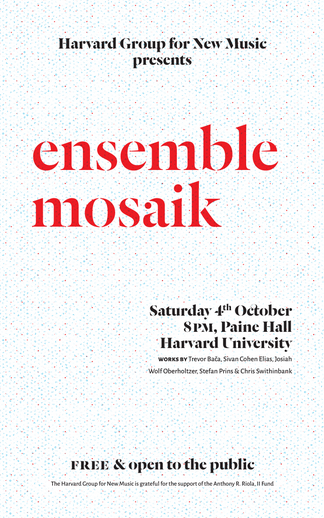Since 2011, I have made occasional forays into gender auditing as a way of paying attention to my position in the remarkably unequal field of contemporary music composition. My attempts were occasional — a couple of analyses of my immediate environments in recognition of International Women’s Day, some (perhaps brash) comments upon finding myself programmed on all-male concerts — and their irregularity was problematic.
What follows below is the result of restructuring this site. I have built a mechanism that allows me to quickly access up-to-date data for the concerts where my works are and have been performed — a reflection of the community as I participate in it. These are not exhaustive numbers.1 My own personal performance context does not necessarily mirror all of contemporary music.2 Gender inequality is far more complex than a tally of whose music is performed. Gender audits do little to help reveal the causes of inequality. However, I do believe that at the very least they are a reminder of the work still left to do, an aid in strategic “gender mainstreaming,” and for any doubters, proof of a very real imbalance.3
The data on this page includes events since 2007, running up until the time of posting. I don’t currently have the data to analyse how a composer’s age factors into this, but I’m working on it.
Some basic numbers
- Number of works programmed — Total: 361
- Works by male composers: 297 (82.2%)
- Works by female composers: 64 (17.7%)
- Number of concerts — Total: 54
- All-male programmes: 22 (40.7%)
- Works programmed — Total: 6.6
- Works by male composers: 5.4
- Works by female composers: 1.1
Career progression
It is often stated that there is a gradual filtering out of women at every stage of career progression: from school-age music studies, throughout academic pathways, and later in professional contexts. My data is limited, but I can compare the 4 years I was an undergraduate and masters student at the University of Manchester — when the vast majority of my performances were in student contexts and 24.7% of works performed were by female composers — with the period since then, for which that figure is just 14.6%. That amounts to a drop in representation of 40.8% in the 5 years since my Masters graduation.
An overview of all the concerts
- 20/12/2014: ensemble mosaik — 1/6
- 16/12/2014: Duo Vignaroli-Öhman — 0/6
- 12/12/2014: Schallfeld Ensemble — 0/7
- 7/12/2014: Duo Vignaroli-Öhman — 1/6
- 6/12/2014: clapTON Ensemble — 0/4
- 20/11/2014: DieOrdnungDerDinge — 3/7
- 4/10/2014: ensemble mosaik — 1/5
- 26/6/2014: Duo Vignaroli-Öhman — 0/5
- 27/5/2014: Haruka Inoue — 0/4
- 17/5/2014: ELISION Ensemble — 3/7
- 8/5/2014: HYDRA — 0/7
- 26/4/2014: Ensemble Dal Niente — 0/3
- 12/4/2014: Callithumpian Consort — 0/2
- 8/3/2014: hand werk — 4/9
- 22/2/2014: Fonema Consort — 0/6
- 6/10/2013: Laura Catrani & Quartetto Maurice — 0/10
- 12/9/2013: Longleash — 1/6
- 4/9/2013: Orfea Duo — 2/13
- 24/3/2013: soundinitiative — 2/3
- 22/3/2013: Curious Chamber Players — 2/7
- 3/2/2013: soundinitiative — 2/5
- 22/9/2012: Marie Picaut, YunPeng Zhao & Guillaume Latour — 1/7
- 25/8/2012: Talea Ensemble — 2/6
- 21/6/2012: Trami Nguyen — 0/5
- 2/4/2012: Joshua Hyde — 1/8
- 31/3/2012: Haruka Inoue — 1/7
- 21/1/2012: San Francisco Tape Music Festival — 1/11
- 5/12/2011: soundinitiative — 1/6
- 22/10/2011: soundinitiative — 0/6
- 7/10/2011: Raise Your Voice Ensemble — 0/5
- 2/9/2011: Sonorous-Horreum — 2/25
- 18/6/2011: King Edward Musical Society — 0/5
- 4/4/2011: Trio Atem — 2/7
- 7/3/2011: Sebastian Grand — 0/4
- 6/3/2011: MANTIS — 2/9
- 30/9/2010: Emma Richards — 0/4
- 4/9/2010: Encuentros Cuenca — 2/9
- 8/6/2010: Vaganza — 0/5
- 16/5/2010: Vaganza — 1/5
- 14/5/2010: Raise Your Voice Ensemble — 0/7
- 30/4/2010: Psappha — 2/5
- 26/4/2010: Steve Pycroft — 2/7
- 28/2/2010: Raise Your Voice Ensemble — 3/8
- 26/2/2010: Trio Atem — 1/6
- 26/11/2009: Olivia Jageurs — 4/8
- 31/10/2009: MANTIS Festival — 1/5
- 28/5/2009: Robert Guy — 0/3
- 9/5/2009: Robert Guy — 0/3
- 20/3/2009: Vaganza — 0/7
- 5/12/2008: Trio Atem — 3/7
- 21/11/2008: Vaganza — 0/8
- 12/5/2008: Vaganza — 4/10
- 11/3/2008: Vaganza — 3/8
- 16/3/2007: Vaganza — 3/7
- Just 2 concerts (of 54) have featured a programme where half or more of the works are by female composers.
- On average just 17.7% of works played are by female composers.
The data
If you are code-minded and would like to play around with the event data, download the event data JSON-LD file. It contains data for every event in my archive, marked up with schema.org vocabularies.
An up-to-date summary of all the data, can always be found on the Gender Audit page.
-
I have kept a complete archive of events, but have not necessarily kept full programme listings for every concert. I have tried to collect that information wherever it is still available online. For some of the measures shown below the sample is of course pretty small, and there are undoubtedly biases introduced by the fact that these concerts all feature at least one of my own works. ↩
-
Although I would bet on it being reasonably representative. ↩
-
Caroline Moser makes clear the challenges implicit in carrying out gender audits in ‘An Introduction to Gender Audit Methodology: Its Design and Implementation in DFID Malawi’, London: Overseas Development Institute, 2005. ↩


